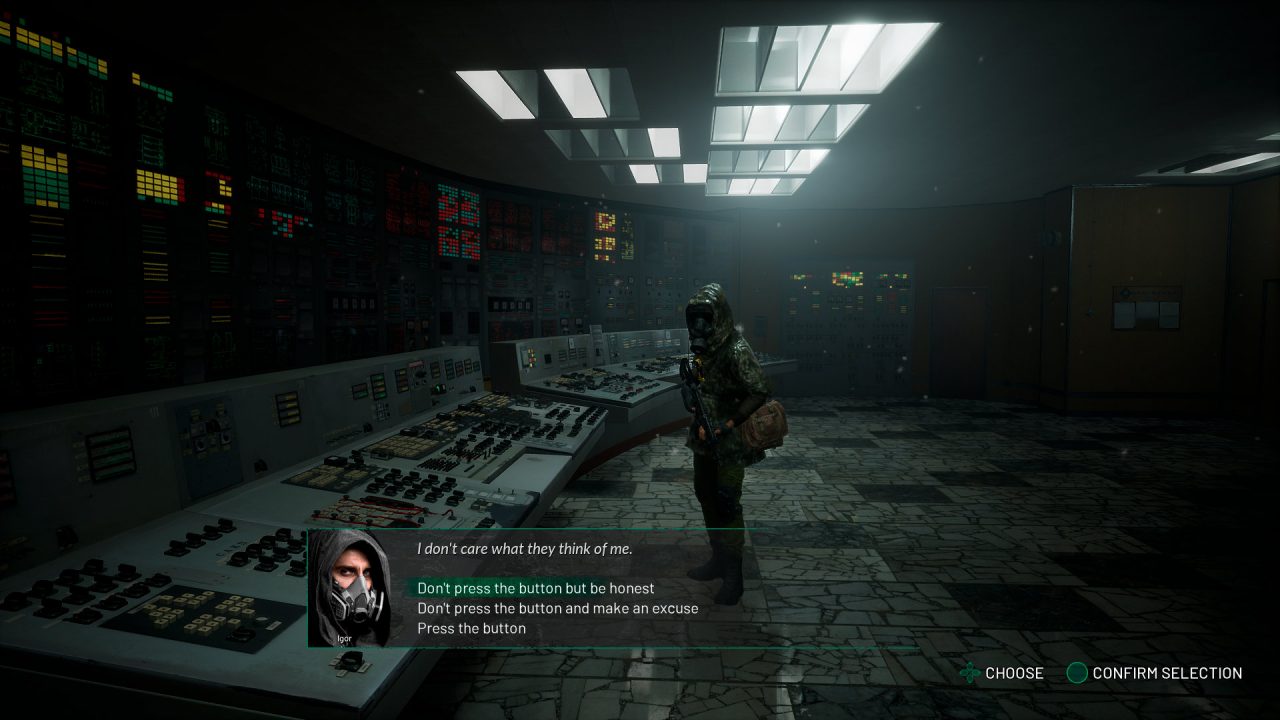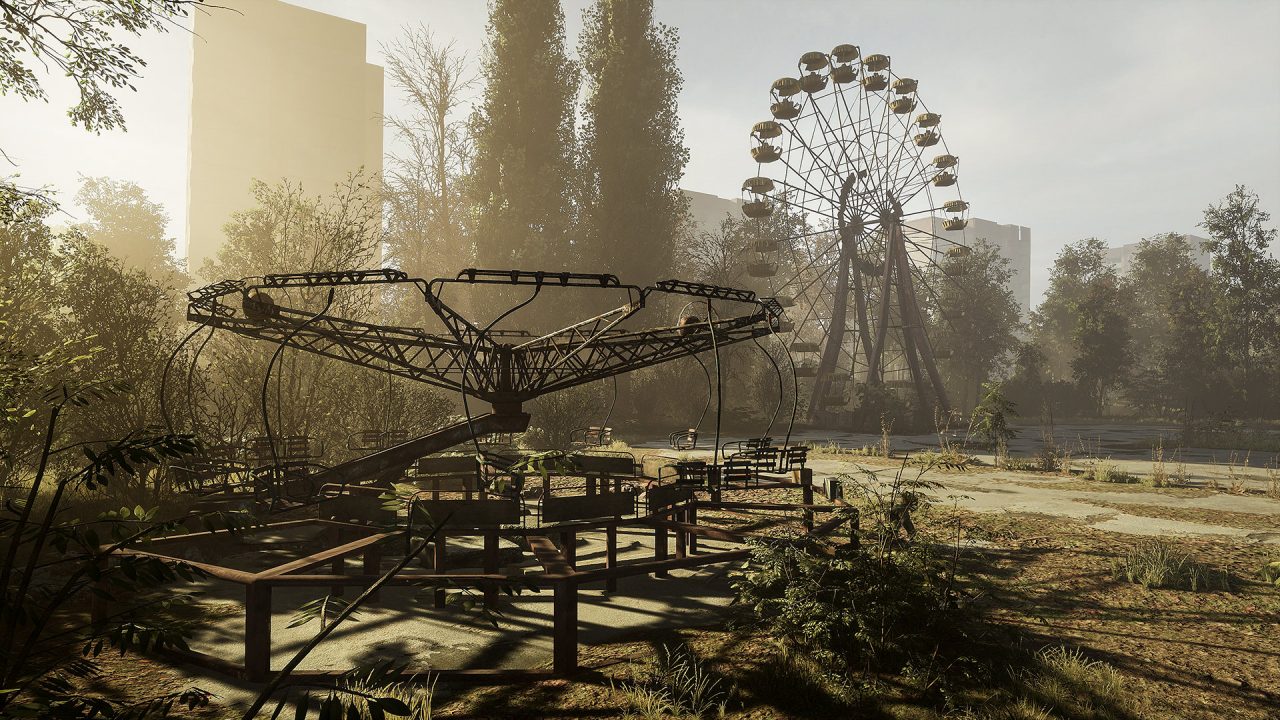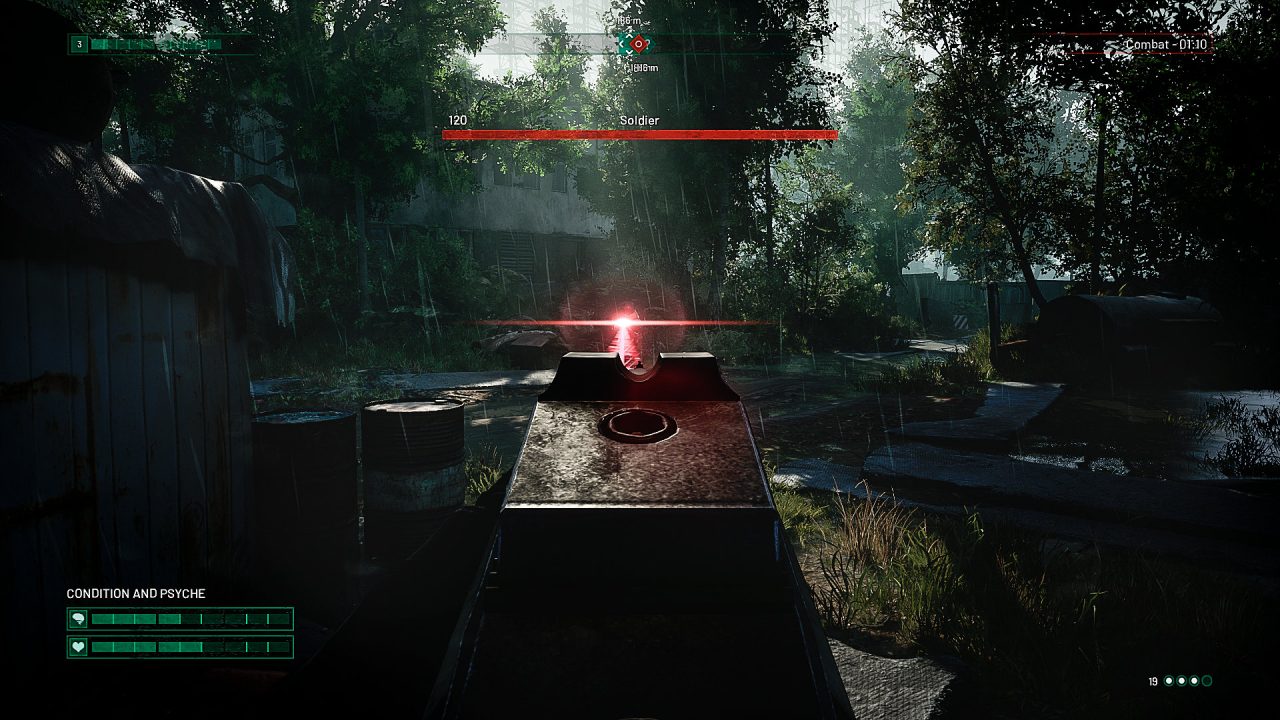“She blinded me with science!” – Thomas Dolby
Technological advancement is a double-edged sword. The pursuit of making life more convenient or enjoyable often comes at the cost of adding misery and suffering to the world. The harnessing of nuclear energy especially has been used for intentionally destructive purposes. But it’s easy to see how utilizing it as a tremendously powerful and unlimited yet clean energy alternative to coal and fossil fuels was at one point an alluring prospect — almost a philosopher’s stone. Unfortunately, the world has witnessed the downside of nuclear energy when reactors have failed, notably the Chernobyl plant disaster of 1986 near Pripyat, Ukraine. The radiation from the explosion that occurred there is expected to last for 20,000 years, making the surrounding land mostly uninhabitable.
This brings us to Chernobylite, in which Igor Khymynuk, a former nuclear engineer at the plant, chooses to inhabit the exclusionary zone anyway. Thirty-plus years after the disaster, Igor is searching for answers about his wife Tatyana’s disappearance around the time of the explosion. Coincidentally, a mysterious substance dubbed chernobylite has since been discovered to be growing out of the reactor core. The shadowy corporation NAR has taken control of the zone, attempting to use the chernobylite for some unknown purpose.
Developers The Farm 51 have woven a fascinating, twisting, mysterious narrative and placed it in a highly ambitious first-person, sci-fi/horror, survival RPG. Chernobylite explores technological advancement (mostly its dark side) and the human cost of experimentation — relevant themes when using Chernobyl as a backdrop — as well as the importance of maintaining your humanity in dire situations where immediately, it might be easier not to. The story is set in the trappings of a political spy thriller, along with some Lovecraftian horror to keep you up at night, in an atmosphere that’s not so much dreamlike as it is hallucinatory.

Igor is far from the exclusionary zone’s only inhabitant. Throughout your journey, you cross paths with a host of odd characters, some of whom join you as companions at your base. Mikhail is a rogue spy who generally solves his problems by blowing them up; Tarakan kind of defies description, but he talks about rats a lot, has added horns to his gas mask, and at one point describes himself as “more real than you are.” The characters are endlessly entertaining, if not particularly deep. Your job is to keep your companions’ morale up, and failure to do so may cause their job performance to lag in the missions you send them on, putting them at greater risk of failing or even being captured. They could even leave your group if they hate your guts enough.
Your comrades can teach you Perks in exchange for experience points, and you get a fun one-on-one training vignette with your teammate, a nice touch over the typical lifeless skill tree. It makes sense that all the characters in the game would wear gas masks as a safety precaution against Covid for the radioactivity in the exclusionary zone. But the masks also obscure their visages, which is appropriate as you never know how much you should trust these misfits. As a side note, it’s unfortunate and disappointing that besides Tatyana, the only other woman in the game is your companion, Olga. She’s a fine character, but she’s even in part defined by her significant other — a man — in a way none of the other characters in the game are, except for Igor.
Often, you’re faced with Big Important Decisions™ that have a measurable effect on your future. Your choices affect your reputation with your companions, and your friends’ interests usually conflict with one another. Sometimes, your actions affect something tangible, such as the NAR’s troop patterns. Other times, they drastically alter the narrative, possibly causing potential companions to decide against joining your team or locking you out of certain quests. These decisions are immediately impactful, too, with literally explosive results — such as causing the massive Moscow Eye satellite structure to collapse in one case — stamping an exclamation point on your completed missions. It is possible to change choices you’ve made in the past, though not necessarily easy.
Whether to consider Chernobylite’s setup “open-world” is a little complicated. Instead of a single, unbroken world, there are five locations available from the hub of your base. There are so many dynamic elements — weather effects, characters appearing in different locations, changing patterns of NAR soldiers — that the overarching Chernobyl world (sounds like one weird amusement park) encompassing those maps feels alive. Every day, you have your choice of quests, each taking place in a different area. There are also optional hotspots represented by question marks that change each time you enter a map. You never know what you’ll find, but strange things are usually afoot at those spots. I’m not aware of any other attempts at setting a horror game in an open-world environment, but combining these two elements only helps evolve them effectively here. Because you’re never sure what you might encounter on the way to your next destination, Chernobylite keeps you constantly on guard, which helps to alleviate that common complaint of open-world games feeling empty.

If you’re feeling scared, that’s alright, because you should be. The random events you stumble onto range from rarer, more elaborate scenes of horror to ones that you might find several times. But the dynamic appearances of the humanoid Chernohosts and arachnid-like Dusters while you’re exploring set this game apart from more scripted horror games like Resident Evil. The creatures’ designs are simple yet unnerving to behold, and my stomach sank whenever I spotted them. My fear of the monsters did wear off eventually, as I grew more capable of dealing with them. Still, I was always on edge when making my way through one of the many dark, claustrophobia-inducing buildings, waiting for a portal to open up and deliver fresh horrors. When you find outcroppings of chernobylite lining a building’s wall, you know you’re in for a wild ride inside.
Firefights feel more realistic as you don’t have a targeting reticule and must look down the sights of your guns to hit enemies. There are only a few guns available, but all of them pack a satisfying punch when you fire them. Crafting upgrades can change your weapons drastically; adding a scope can transform your standard AK47 into a sniper rifle, for instance. There is a slight sluggishness to controlling Igor that can make combat feel unwieldy, though he does start to move around better as you level him up. Granted, it makes sense that this aging scientist won’t be an action hero his first day in the zone. Anyway, violence is often not the answer because Igor’s psyche suffers whenever he encounters monsters or kills humans. You also can craft a variety of traps while in the field, and using stealth to avoid fights is usually a viable option. The incomprehensible horrors Igor sees do enough damage to his mind, so you don’t want too many humans’ deaths weighing on his conscience to compound his internal struggles. You can chase away those inner demons with (what else?) vodka, though.
If you’re not exploring the exclusionary zone, you spend your time chilling at your makeshift base in an abandoned warehouse. From here, you can work on tools for your next quest, but don’t neglect your friends’ needs. No one likes an unthoughtful roommate. You can concoct all manner of supplies, from bullets to healing items to vodka. As you craft more and more workbenches and comfort items, such as lights or TVs, your barren trash heap gets a makeover into something that looks not entirely unlivable. Your resources are limited, but it’s always exciting to see what new things you can make next. Having more stuff is generally reflective of Igor’s significant progression as a survivor of the zone.
When your health bar is depleted in the field, you usually find yourself imprisoned at the NAR base, and you have a chance to escape. If you die there, you lose some items. It’s a setback, but it isn’t debilitating. After running through the NAR segment a few times, I begged the game to let me skip it and just take the items because it got old quickly. But even though you may lose some items occasionally, you get to keep most of your stuff when you die, so it still always feels like you’re making progress à la Dark Souls. That’s helpful, as I died frequently on the challenging default difficulty, though there is a Very Easy setting if you need it.

Visually, Chernobylite is a technical marvel, with The Farm 51’s painstaking lifelike recreation of sites in the real-world exclusionary zone. The game is flooded with the color green, from the overwhelming plant life to the monsters’ radioactive hue to the glowing chernobylite rocks. The weather effects are especially impressive. If you’re from the U.S. Midwest like I am, you’re used to big storms, where the sky turns green, and the trees sway in the heavy winds; the developers have perfectly captured that kind of fearsome scene. If Jaws made you afraid to go in the water, Chernobylite might make you afraid to go out in thunderstorms. The synth-heavy music is also excellent; as any horror buff knows, the frights don’t work without a great soundtrack. I stuck with the original Russian voice acting, which felt pretty natural, as English-language actors invariably read their lines too quickly. However, it’s understandable that the timing of the cutscenes may have complicated the transfer between languages.
Chernobylite is a solid game with a thoughtful story, enjoyable characters, memorable scares, and amazing design. You have freedom in the directions you want to go with crafting and leveling up, and the narrative choices you make feel meaningful. The game keeps you constantly engaged, as it always feels like there’s an important mission to complete or something to take care of around the base. The mystery is fascinating all the way to the end, and the main narrative doesn’t overstay its welcome, feeling spot on at a tight 20-ish hours. If you’ve ever wanted to tour the Chernobyl area but were afraid of the radiation, here’s your ticket to some of the sites, with some monsters tossed in to keep things lively (or deadly). So what are you afraid of?


